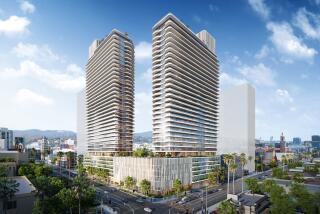Tower Homes Nearer Employment Areas Prophesized : Conference on Skyscrapers Forecasts Increasing Moves to Downtown High-Rises
- Share via
CHICAGO — Shifts in employment, greater value placed on discretionary time, escalating land costs and changing attitudes toward living downtown will contribute to an increase in residential high-rise living, concluded speakers at the international conference on “The Second Century of the Skyscraper” here.
Travel times are becoming more important as people become better educated, Houston developer Gerald D. Hines said. “The desire for discretionary time will lead to more residential high-rises close to downtown work,” he said.
Richard Kateley, executive vice president of Real Estate Research Corp., Chicago, said office workers, unlike factory workers, want to live near work and have turned to downtown living because yuppies have made it acceptable.
Design Changes Seen
“Yuppies are interested in being where the action is, not out in the suburbs,” Kateley said. “Their numbers are actually small but they brought entertainment and retailers back to downtown areas. They’ve created an aura that has made living downtown acceptable.”
Single and divorced individuals, including working women, and elderly “empty nesters” are as big a segment of the population as the yuppies, have relatively high incomes, and many want to live downtown, he maintained.
In discussing high-rises in general, architect John Rankine, of Sydney, Australia, and other experts at the conference foresaw changes that will affect their design.
The role of the skilled craftsman will make a comeback, predicted New York architect Alan Ritchie, who said this trend began with Philip Johnson’s AT&T; Building in New York. New buildings in New York, Chicago, San Francisco and elsewhere are finding ways to relate to surrounding buildings through their use of details and material, he said.
Greed and Ego
Too many buildings have been designed recently to serve the greed and ego of their builders, said Ritchie, one of nearly 100 speakers at the conference which was sponsored by the Council on Tall Buildings and Urban Habitat, of Bethlehem, Pa., the Chicago Committee on High Rise Buildings, the National Science Foundation, Federal Emergency Management Agency and Graham Foundation.
These buildings also have been too isolated, complained Leonard Ruchelman, chairman of the Department of Urban Studies and Public Administration at Old Dominion University, Norfolk, Va.
“Detroit’s Renaissance Center is anti-street,” he said. “It prohibits the movement of people from the streets to the building. Streets should be maintained as lively and interesting places to be.”
San Francisco’s assistant director for plans and planning, George Williams, said flat-topped towers without the details that make them blend into their surroundings run counter to San Francisco’s character.
But tall buildings are not in themselves bad, speaker after speaker insisted.
Too many people identify tall with bad and low with good, said architect Bruce Graham, partner in charge of design at Skidmore, Owings and Merrill, Chicago, and the designer of Sears Tower and the John Hancock Building, both in Chicago.
Towers have been important contributors to the character of many cities, he said, referring to the Eiffel Tower in Paris, the church steeples in French and Italian cities and the minarets of mosques of Istanbul and Cairo.
In Mexico City, said San Francisco architect Chris Arnold, it was the buildings of six to 20 stories that received more damage than the low-rise and high-rise buildings. Many high-rise buildings were not damaged at all, he said.
Whatever changes occur in tall-building design, computers will play a part. “Computer-assisted design allows you to propose grand ideas economically,” Graham said.
“The next generation of tall buildings,” said architect Bill Lim, of the National University of Singapore, at the concluding session “will be upscale, multiple-use, intelligent buildings and they will be adjusted to the environment. At the same time competition to build will be very keen, so there will be more planning.”
More to Read
Sign up for Essential California
The most important California stories and recommendations in your inbox every morning.
You may occasionally receive promotional content from the Los Angeles Times.






